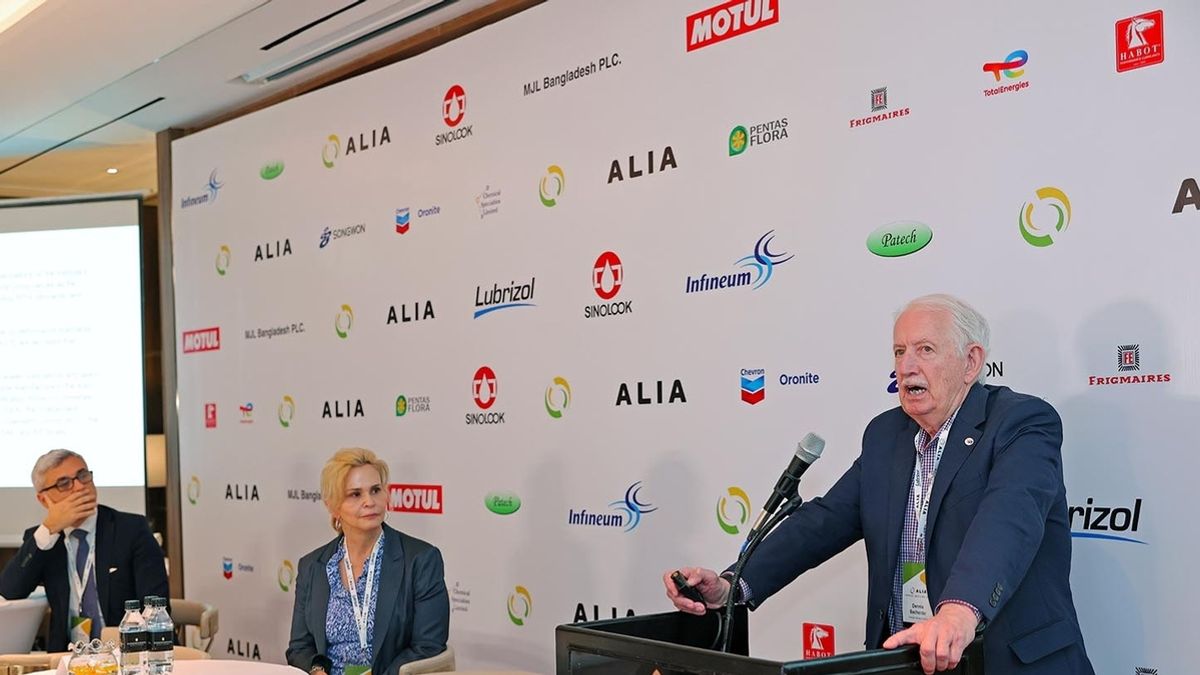I mean, M1 0W40 has been around forever but again, I think the 0 part scared the vape-bois...er...Subi kids away and they fled to the Brotella.Pretty much. I became exposed to T6 5w-40 from the Subaru world as it was an alternative to the oem spec'd 5w-30. At the time, the talk was how 5w-30 sheared and burn off, so the simplest, easily available alternative was T6. If you were really into Euro oil's, it was the green savior of Castrol 0w-30. I ran T6 in my Subaru and never had a problem. But today, I would just pick one of the many flavors of 0w/5w-40 available everywhere.
T6 being intended as a mixed fleet oil (at least the S rated versions) it has its purpose in gas engines too. But really comes down to application. These mixed fleets are primarily used for work where there's idling, normal driving to work sites, hauling, etc.; applications that don't usually see high rpms. And of course there's the added benefit to the operators of simplified maintenance/costs within the fleet.
You are using an out of date browser. It may not display this or other websites correctly.
You should upgrade or use an alternative browser.
You should upgrade or use an alternative browser.
LSjr Tests VOA of 20 yr old Valvoline & 40 yr old Mobil 1 Oil. HPL tests Anti-Foam in Gear Oil.
- Thread starter fantastic
- Start date
- Joined
- Mar 1, 2024
- Messages
- 322
They're like Lemmings.I mean, M1 0W40 has been around forever but again, I think the 0 part scared the vape-bois...er...Subi kids away and they fled to the Brotella.
Sure, part of it was the 0 part, but largely this stemmed from the Owner's Manual. Much like many OM's that state contradictory information, Subaru notoriously stated "5w-40 conventional oil may be used"...Now, tell where one can find 5w-40 Conventional?...So enter mixed fleet 5w-40. Rotella was the darling but many ran other flavors like Delo.I mean, M1 0W40 has been around forever but again, I think the 0 part scared the vape-bois...er...Subi kids away and they fled to the Brotella.
Hits vape....adjusts flat-brimmed hat....hits oil aisle at Wally for some of that choice bro to the tella...Sure, part of it was the 0 part, but largely this stemmed from the Owner's Manual. Much like many OM's that state contradictory information, Subaru notoriously stated "5w-40 conventional oil may be used"...Now, tell where one can find 5w-40 Conventional?...So enter mixed fleet 5w-40. Rotella was the darling but many ran other flavors like Delo.
View attachment 207136
- Joined
- Mar 1, 2024
- Messages
- 322
You really dislike Rotella, don't you?Hits vape....adjusts flat-brimmed hat....hits oil aisle at Wally for some of that choice bro to the tella...
ZERO??? Omg that stuffs like waterI mean, M1 0W40 has been around forever but again, I think the 0 part scared the vape-bois...er...Subi kids away and they fled to the Brotella.
For the way many use it vs. better Euro gas engine oils...yes.You really dislike Rotella, don't you?
Probably only anecdotal.
API CK-4 and API SP both have the Sequence I–III D892 93.5 °C foaming tests, and the API CK-4 limit on Sequence II is stricter. However, API SP also has a D6082 150 °C Sequence IV foaming test, which API CK-4 doesn't have.
I dont use T6 anymore (used too in my WRX, went with A40 oils) but Can we put this into perspective? So sure foam is bad since it's compressible so zero is best. But how does that compare the specs and other similarly priced oils?
Looking at https://www.infineum.com/media/w5kpot0y/api-engine-oil-classifications-brochure2.pdf
CK4 ASTM D892 (Sequence I, II, III) (tend/stab ml)
10/0 max
20/0 max
10/0 max
API SP
10/0 max
50/0 max
10/0 max
100/0 max (D6082) (Seq IV)
Which test is depicted above? Does rotella not meet it's own CK4 spec?
Rotella is well outside of CK-4 limits. Even if you were to cut the amount of foam in half, it's still >25% over the limit.
- Joined
- Mar 1, 2024
- Messages
- 322
I'm 100% there with you, that's why I posted the Lemmings reference earlier. It's an old game from the early 90s, and you can see how they follow each other blindly.For the way many use it vs. better Euro gas engine oils...yes.
Mobil 1 FS 0W-40 - Zero Foam (Porsche doesn't allow for any foaming for any of their OEM Approvals). So, then why use HDEO in an application that's clearly not meant for, when the right oil costs even less and it's actually suitable?So sure foam is bad since it's compressible so zero is best. But how does that compare the specs and other similarly priced oils?
Rotella is well outside of CK-4 limits. Even if you were to cut the amount of foam in half, it's still >25% over the limit.
This makes me think of the "cert vs non-cert" oil debate. There's a lot of people here who would choose Rotella over HPL (or Amsoil or Red Line, etc...) because of the API starburst. CK-4 allows a max of 20 ml in Sequence II. T6 produced >50 ml here. Even if the test was erroneous and it only foamed half as much (way outside of MoE), it would still be >25 ml. That's what I was getting at. It brings Rotella's starburst into question. If it fails D892 so miserably... how can we trust it actually passes the rest of the required tests?
Noack is coming to mind. How does this effect solutocapillary stabilization driven by evaporation? Does the marangoni principle suggest the changes of surface tension, with temperature and foam/aeration, in such a case as this would promote a higher volatility in the high windage environment of a crankcase? I now must dive into the white paper rabbit hole.
Noack is coming to mind. How does this effect solutocapillary stabilization driven by evaporation? Does the marangoni principle suggest the changes of surface tension, with temperature and foam/aeration, in such a case as this would promote a higher volatility in the high windage environment of a crankcase? I now must dive into the white paper rabbit hole.
Last edited:
Back in the day I think it was because diesel oils still had higher levels of ZDDP. The good ol "more is better" argument.I've never understood why people would spend a ton of money to build a 700+ HP RB26 just to cheap out on the oil. They either think "This oil is good enough for a diesel so it's good enough for my gas engine with 1/4 the sump capacity and 3x the rpm" or "Oil is oil, use what's cheap." What's more sad is many of these guys are quite educated and experienced in engine building and racing, but think the "W" in an oil grade stands for weight. The oil is the blood of the engine. The healthiest heart will be weak if the blood is anemic.
- Joined
- Mar 1, 2024
- Messages
- 322
Reputation and transparency are everything. AMSOIL holds itself to a high standard, and its facility has been filmed and documented multiple times (these can be found on YouTube). HPL has hosted multiple Open House Events, giving the public access to tour their facility and offering full transparency into their process. Red Line Oil has limited contact with the public outside of trade shows and racing events, possibly because that is the niche it targets.This makes me think of the "cert vs non-cert" oil debate. There's a lot of people here who would choose Rotella over HPL (or Amsoil or Red Line, etc...) because of the API starburst.
The only major blender that has allowed its facilities to be filmed and documented is Mobil. They showed how they test their engine oils for the most part. The other major blenders have never shown anything outside of promotional materials.
Out of all the blenders, HPL is the single company I have seen that offers full transparency into its process and is willing to talk to the public openly about its products. In this secretive industry, that takes a lot of courage and even more knowledge.
It would be interesting to see if API would refocus its testing / auditing on suspect oils after certification and actually publish them. Until then I appreciate HPL publishing its own results, but like the scientific method demands we need more public tests.
4WD
$50 site donor 2024
Let me go count the Rotella -vs- HPL threads …
Don’t order dinner yet, this will be quick …
Don’t order dinner yet, this will be quick …
Relevant...

 bnnbreaking.com
bnnbreaking.com

Nearly Half of API Engine Oil Samples Fail to Meet Standards, Reveals Audit
API's AMAP program exposes nearly half of tested engine oil samples fail to meet EOLCS standards, raising quality and trust concerns.
 bnnbreaking.com
bnnbreaking.com
- Joined
- Mar 1, 2024
- Messages
- 322
@Tom NJ posted this in another thread. The thing is that it's very poorly written IMHO. That doesn't mean it's not true, I just wish the author would have gone into more depth.Relevant...

Nearly Half of API Engine Oil Samples Fail to Meet Standards, Reveals Audit
API's AMAP program exposes nearly half of tested engine oil samples fail to meet EOLCS standards, raising quality and trust concerns.bnnbreaking.com
Like others here, I also question LSJr's conclusions. All his old oils are severely darkened/oxidized. In my experience, that just does not happen with sealed bottles. Here is a photo I took today of my oldest oil on shelf: Quaker State Ultimate Durability Full-Synthetic 0W-20 manufactured on 05 Oct 2010, so 13.5 years ago. The color is as light as it was when I bought it. There is absolutely no sediment at the bottom, and I mean zero. Nothing has fallen out of suspension. I am currently running this oil in a frankenbrew with Amazon Basics Euro 0W-40 (2022 vintage).

All things considered, though, I think I will post on Marketplace and try and reduce my oil stash somewhat. I have 316 quarts, mostly from 2019-2023.
All things considered, though, I think I will post on Marketplace and try and reduce my oil stash somewhat. I have 316 quarts, mostly from 2019-2023.
Relevant...

Nearly Half of API Engine Oil Samples Fail to Meet Standards, Reveals Audit
API's AMAP program exposes nearly half of tested engine oil samples fail to meet EOLCS standards, raising quality and trust concerns.bnnbreaking.com
This makes me think of the "cert vs non-cert" oil debate. There's a lot of people here who would choose Rotella over HPL (or Amsoil or Red Line, etc...) because of the API starburst. CK-4 allows a max of 20 ml in Sequence II. T6 produced >50 ml here. Even if the test was erroneous and it only foamed half as much (way outside of MoE), it would still be >25 ml. That's what I was getting at. It brings Rotella's starburst into question. If it fails D892 so miserably... how can we trust it actually passes the rest of the required tests?
It makes one think of how many oils would fail one or more tests after certification/licensing, name brand or not.
We have seen variations in VOA/UOA's and often attribute to "reformulations" or testing errors/noise/tolerances but who really knows.
Hopefully it's not wide spread "fake it to make it" but wouldn't be surprised either.
Similar threads
- Replies
- 96
- Views
- 13K
- Replies
- 12
- Views
- 5K
- Replies
- 14
- Views
- 2K
- Locked
- Replies
- 5
- Views
- 31K
- Replies
- 16
- Views
- 7K
